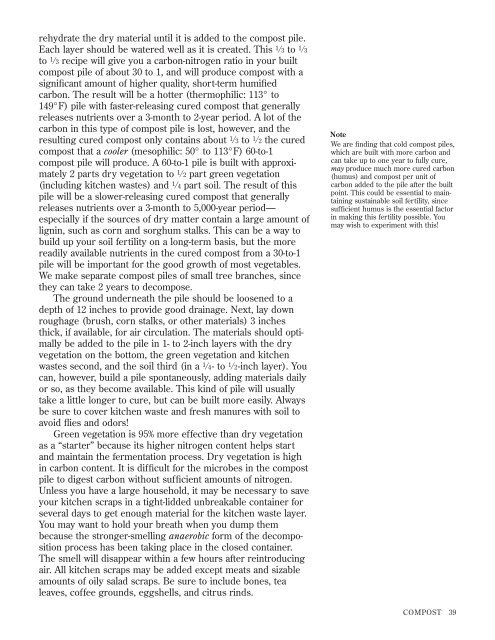How to Grow More Vegetables : And Fruits, Nuts ... - Shroomery
How to Grow More Vegetables : And Fruits, Nuts ... - Shroomery
How to Grow More Vegetables : And Fruits, Nuts ... - Shroomery
You also want an ePaper? Increase the reach of your titles
YUMPU automatically turns print PDFs into web optimized ePapers that Google loves.
ehydrate the dry material until it is added <strong>to</strong> the compost pile.<br />
Each layer should be watered well as it is created. This 1 ⁄ 3 <strong>to</strong> 1 ⁄ 3<br />
<strong>to</strong> 1 ⁄ 3 recipe will give you a carbon-nitrogen ratio in your built<br />
compost pile of about 30 <strong>to</strong> 1, and will produce compost with a<br />
significant amount of higher quality, short-term humified<br />
carbon. The result will be a hotter (thermophilic: 113° <strong>to</strong><br />
149°F) pile with faster-releasing cured compost that generally<br />
releases nutrients over a 3-month <strong>to</strong> 2-year period. A lot of the<br />
carbon in this type of compost pile is lost, however, and the<br />
resulting cured compost only contains about 1 ⁄ 3 <strong>to</strong> 1 ⁄ 2 the cured<br />
compost that a cooler (mesophilic: 50° <strong>to</strong> 113°F) 60-<strong>to</strong>-1<br />
compost pile will produce. A 60-<strong>to</strong>-1 pile is built with approximately<br />
2 parts dry vegetation <strong>to</strong> 1 ⁄ 2 part green vegetation<br />
(including kitchen wastes) and 1 ⁄ 4 part soil. The result of this<br />
pile will be a slower-releasing cured compost that generally<br />
releases nutrients over a 3-month <strong>to</strong> 5,000-year period—<br />
especially if the sources of dry matter contain a large amount of<br />
lignin, such as corn and sorghum stalks. This can be a way <strong>to</strong><br />
build up your soil fertility on a long-term basis, but the more<br />
readily available nutrients in the cured compost from a 30-<strong>to</strong>-1<br />
pile will be important for the good growth of most vegetables.<br />
We make separate compost piles of small tree branches, since<br />
they can take 2 years <strong>to</strong> decompose.<br />
The ground underneath the pile should be loosened <strong>to</strong> a<br />
depth of 12 inches <strong>to</strong> provide good drainage. Next, lay down<br />
roughage (brush, corn stalks, or other materials) 3 inches<br />
thick, if available, for air circulation. The materials should optimally<br />
be added <strong>to</strong> the pile in 1- <strong>to</strong> 2-inch layers with the dry<br />
vegetation on the bot<strong>to</strong>m, the green vegetation and kitchen<br />
wastes second, and the soil third (in a 1 ⁄ 4- <strong>to</strong> 1 ⁄ 2-inch layer). You<br />
can, however, build a pile spontaneously, adding materials daily<br />
or so, as they become available. This kind of pile will usually<br />
take a little longer <strong>to</strong> cure, but can be built more easily. Always<br />
be sure <strong>to</strong> cover kitchen waste and fresh manures with soil <strong>to</strong><br />
avoid flies and odors!<br />
Green vegetation is 95% more effective than dry vegetation<br />
as a “starter” because its higher nitrogen content helps start<br />
and maintain the fermentation process. Dry vegetation is high<br />
in carbon content. It is difficult for the microbes in the compost<br />
pile <strong>to</strong> digest carbon without sufficient amounts of nitrogen.<br />
Unless you have a large household, it may be necessary <strong>to</strong> save<br />
your kitchen scraps in a tight-lidded unbreakable container for<br />
several days <strong>to</strong> get enough material for the kitchen waste layer.<br />
You may want <strong>to</strong> hold your breath when you dump them<br />
because the stronger-smelling anaerobic form of the decomposition<br />
process has been taking place in the closed container.<br />
The smell will disappear within a few hours after reintroducing<br />
air. All kitchen scraps may be added except meats and sizable<br />
amounts of oily salad scraps. Be sure <strong>to</strong> include bones, tea<br />
leaves, coffee grounds, eggshells, and citrus rinds.<br />
Note<br />
We are finding that cold compost piles,<br />
which are built with more carbon and<br />
can take up <strong>to</strong> one year <strong>to</strong> fully cure,<br />
may produce much more cured carbon<br />
(humus) and compost per unit of<br />
carbon added <strong>to</strong> the pile after the built<br />
point. This could be essential <strong>to</strong> maintaining<br />
sustainable soil fertility, since<br />
sufficient humus is the essential fac<strong>to</strong>r<br />
in making this fertility possible. You<br />
may wish <strong>to</strong> experiment with this!<br />
COMPOST 39












